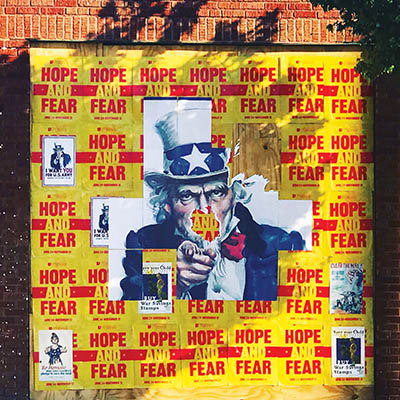Here today, gone tomorrow
Tulsa struggles with street art
A man paints over a mural by Donald Ross, aka Scribe, in the Brady Arts District on July 14
Julia White
Thanks to the dedication of large-scale installationists, such as Jake Beeson, Chris Sker, and Aaron Whisner, street art in Tulsa has seen significant growth in recent years. Once mundane walls are now beautified, like Codak Smith and Yatika Starr Fields’ mural at 803 S. Peoria Ave. and the Gateway Building at 823 E. 1st Street.
However, this growth was stunted when a mural painted by renowned Kansas City artist Donald “Scribe” Ross during the second annual Habit Mural Festival was covered up on June 14—an act considered a misstep by many in the Tulsa art community. KJRH reported that the building’s property manager never gave “final approval” and received complaints from tenants.
“This felt like a personal assault on myself, Scribe, and those that poured so much into making Habit happen,” said Aaron Whisner, artist and director of Habit Mural Festival.
“Here today, gone tomorrow” is a sentiment street artists are forced to live by. While part of the beauty of street art is its ephemeral nature, this experience was different.
The Tulsa Artist Fellowship hosted a public discussion on July 21 with Whisner and artists Scribe, Smith, Sker, and L.A. artist Eyeone. They provided insight into the role of graffiti and street art in Tulsa and communities around the world.
When the discussion concluded, panelists opened it up to the floor for questions. I asked the artists if they were aware of a similar incident that also occurred in the Brady Arts District just weeks after Scribe’s mural was covered up.
Philbrook Art Museum had installed reproductions of WWI propaganda posters to supplement a collection of original posters on display at the museum. With permission from Welltown Brewery, they mounted posters with rollers, paste, and staples onto a wall on West Archer Street. The intention was to give the community the experience of viewing the posters in their intended location: the street. Like the mural, the installation was also taken down—but in this situation, Philbrook doesn’t know who is responsible.
 “Some of the stuff we had to get on a ladder to put up, so it wasn’t an easy thing to take down,” said Jeff Martin, communications director at Philbrook.
“Some of the stuff we had to get on a ladder to put up, so it wasn’t an easy thing to take down,” said Jeff Martin, communications director at Philbrook.
Martin acknowledged the possibility of someone taking the art out of context or not understanding the intention behind it.
“It was obviously a concerted effort of some kind to remove them.”
Both incidents raise questions about the place of public art in Tulsa, such as what counts as “public space,” and how much do Tulsans value street art?
Tulsa artists aren’t too shaken by this, and don’t plan to let a few setbacks keep them from creating public art. Funds have been raised to bring Scribe back to Tulsa to paint another mural, and Martin said Philbrook has plans for another public art installation in a new space.
For more from Mary, read her article on Modus, a non-profit providing free transportation to teenagers ages 13–19.


.jpg)
.jpg)
